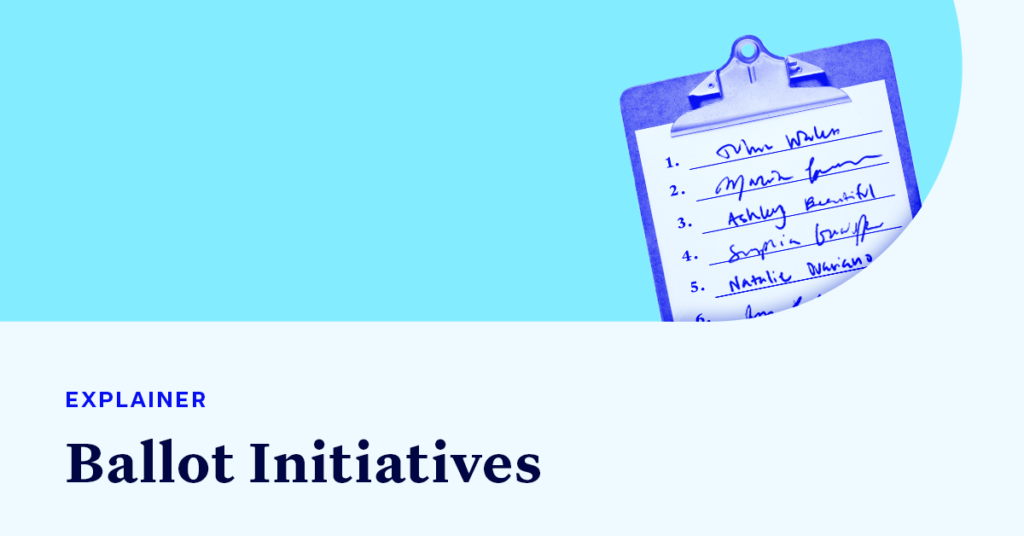The Petition Process and Ballot Initiatives, Explained

In Pennsylvania, Gov. Tom Wolf (D) vetoed a Republican voter suppression bill in June. In Michigan, Democratic Gov. Gretchen Whitmer stands as a bulwark against the Republican-controlled Legislature. In Massachusetts, there is impenetrable Democrat control in the statehouse.
What do Pennsylvania, Michigan and Massachusetts have in common? Republican leaders in these three states, among a handful of others, are attempting to evade Democratic obstruction to voter suppression laws by placing the question in front of the general population instead.
When voters vote directly on policy measures, this is called a ballot initiative.
As we enter the 2022 election cycle, Democracy Docket will be tracking election-related ballot initiatives across the country. And in today’s Explainer, we cover the basics of ballot initiatives so that you can follow these important developments and understand how and why a state law or constitutional amendment may appear on your very own ballot.
What is a ballot initiative?
Ballot initiatives are commonly referred to as ballot measures, voter initiatives or propositions and rely on gathering a certain number of signatures before a question is placed in front of voters or the state legislature. 26 states have an initiative process at the state level, which are categorized as either direct or indirect initiatives. Distinctly, there are also ballot measures where local jurisdictions — such as city and town councils or school boards — refer to voters on policy questions, often related to revenue.
But first, a petition needs to qualify for the ballot by reaching a threshold of voter signatures. Each state has a unique set of requirements, but include some variation of the following:
- Filing a proposed petition with a designated state official or office.
- Review of the petition language and conformance with statutory requirements.
- Circulation of the petition to gather signatures; typically the threshold is a percentage of the votes cast in the preceding statewide election. The signatures are then submitted for verification.
Then, the proposal can go directly on the ballot (direct initiatives) or head to the state legislature (indirect initiatives), with a majority vote typically required for passage. For the nine states with indirect initiatives, a proposal will only go to a popular vote if it is not passed by the legislature within a certain time frame.
There can also be distinct processes depending on whether a ballot initiative seeks to change state statute or the state’s constitution, which can often be long or convoluted undertakings. In Massachusetts, “for example, a proposed constitutional amendment submitted in August of 2019 would have to be approved by 25% of legislators in 2020 and 2021 before appearing on the ballot in November 2022,” reads a document from the Massachusetts attorney general’s office. Mississippi similarly has an indirect amendment process through the Legislature, while the other 18 states that permit citizen-led constitutional amendments are direct.
Additionally, the only form of ballot initiative permissible in Maryland and New Mexico asks whether voters would like to uphold or repeal a law previously passed by the legislature. This is called a veto referendum.
Will I ever see a national ballot measure?
The United States does not have the equivalent of a ballot initiative at the national level, although the idea has been thrown around. The pre-World War II Ludlow Amendment proposed a nationwide vote on declaring war and most recently, 2020 presidential candidate Tom Steyer included a national referendum in his platform.
In contrast, many other countries do hold referendums — what may come to mind is the United Kingdom’s infamous Brexit vote in 2016. Although referendums are hypothetically the most direct form of democracy, political scientists often argue that they are risky, volatile and driven by low-information voters who rely predominantly on political messaging. Consequently, even state-level ballot initiatives depend on messaging to sway voters, pushing up the price tag of these campaigns. According to Ballotpedia, the average cost was over $8 per signature gathered in 2020.
So, which political party relies more on ballot initiatives?
Ballot initiatives are utilized by both parties in the United States. In recent years, progressive policies — such as Idaho’s 2018 Medicaid expansion, Florida’s minimum-wage increase and marijuana legalization in numerous states — have excelled on the ballot. Notably, the establishment of several independent redistricting commissions was accomplished through ballot initiatives. In Florida, although a 2018 constitutional amendment restoring voting rights to those with felony convictions was supported by nearly 65% of the electorate, Republican lawmakers added new hurdles and the battle is still playing out in the courts. In 2021, Republicans across the country have pushed back with a proliferation of new requirements or higher signature thresholds for ballot initiatives.
While Republicans in red states look to curb ballot initiatives, there is a divergent pattern occurring in states with Democratic-controlled institutions. Republicans in places like Michigan and Massachusetts turn to ballot initiatives as a means to skirt blue legislatures or Democratic governors’ veto power. In turn, ballot initiatives are not only a means of direct democracy, but a partisan tool used by both parties to bypass other state-level barriers.
What can I expect this election cycle?
Over 60 statewide ballot measures have already been certified for 2022, with many more just beginning the signature gathering process. Arizona lawmakers are supporting a measure to impose stricter voter ID requirements on early ballots if the initiative can gather over 250,000 signatures by next July. A similar signature-gathering campaign for a voter ID ballot initiative is already underway in Nebraska. In addition to voter ID proposals, keep an eye out for ballot measures on felony voting rights restoration, election governance or changes to the ballot initiative process itself.